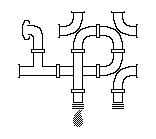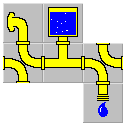
Plumbin'
Smalltalk-80 Application Architecture by Example
Ward Cunningham
Cunningham & Cunningham, Inc.
Computers should devote their full attention to serving the needs of their users. This was understood in 1980. But how exactly does one instruct a computer to do so?
The user-centric battle cry rose over Xerox's Palo Alto Research Center throughout the '70s. Smalltalk was one vehicle for that research. By 1981 I had it running on my desk. And I had source code.
Smalltalk source code was amazingly easy to read. I could flip to just about anywhere, start reading, and make sense of what was there. It reveiled its secrets quickly, except for one: how to make an user-centric application.

Plumbin' has a direct manipulation interface. One arranges assorted tiles by dragging them with the mouse. When dropped, the tile aligns itself percisely with the rest of the mosaic. A shift-drag pulls off a copy of a tile. This makes for an endless supply of material.
Tile
Faucet
Spout
StraightPipe
TeePipe
ElbowPipe
ReverseElbowPipe
PressureTank
Plumbin' is also a simulator. Each tile models a device capable of propagating both pressure and flow. A right-click on the faucet gets a menu for changing the pressure. We offered a pressure tank as an add-on. It relates pressure to flow and vice-versa. The level of the tank (state held within the tile) is animated as the simulation progressed.
The name Plumbin' is a take off on Truckin', another educational simulator developed by the Loops group under Lynn Conway at Xerox PARC. Their spelling probably goes back to the Greatfull Dead, Janice Joplin or Robert Crumb.
Jim Besemer has reminded me that an earlier reference to Truckin' is the old, black, blues musician, Blind Boy Fuller, in his song Keep on Truckin' Baby [Truckin' them blues away...].

I've also added an infinite recursion check. Plumbin' was originally written for a dialect that could only allocate 32 thousand objects. If you assembled a loop of pipe the simple simulator would loop too and quickly exhaust all but a small reserve of the object space -- just enough to bring up a notifier. I thought this behaviour to be quite sophisticated and loved to show it off. Now an infinite loop just drives Smalltalk into paging so I have to explicitly check for loops and issue my own notice.
800k
PlumbinSrc.zip
10k
Hans-Martin Mosner has converted Plumbin' to use Squeak's new Morphic graphics model. File-in this change set after you have tried the MVC version.